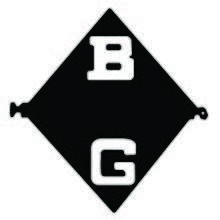Barber Greene
Barber-Greene was a company founded in 1916 by American mechanical engineers Harry H. Barber and William B. Greene. It was formed to sell standardized material-handling machines to mechanize small manual tasks in an economical way. Though the company began by offering conveyors and bucket loaders, it is best known for its contributions to the asphalt field. In 1959, the company went public[1] and was sold to Astec in 1985.[2][3]
 | |
| Industry | Earth Movers, Asphalt |
|---|---|
| Fate | Purchased by Astec Industries of Chattanooga, Tennessee in late 1986. |
| Founded | 1916 in Aurora, Illinois, United States |
| Founders | Harry H. Barber and William B. Greene |
| Defunct | 1985 |
| Headquarters | Aurora , USA |
| Products | Machinery |
History of the Asphalt Paver
On November 15, 1930 in Aurora, Illinois Harry Barber made a sketch of a revolutionary new machine that was to become the Asphalt paver. Harry asked a patent attorney named W.R. Chambers to come from Chicago and see this new machine. The patent was filed on August 20, 1932 with a publication date on December 22, 1936.[4] This eventually became the beginning of the development of the modern asphalt paver. Today, there is an entire industry that has been developed from this invention. The machine featured mixing and then placing asphalt in a single operation. This was exhibited for the first time at the 1931 Road Show in St. Louis. Barber realized that the mixing and placing operations needed to be separated and the mixing section became the line of Barber Greene asphalt plants and the placing section became the Barber Greene paver line.
The early pavers used screw conveyors to distribute the mix in front of a screed that tamped the mix. This process meant that the asphalt was suitable for coarse-graded mixes, however on dense-graded mixes that were common on city streets the machine experienced problems including surface imperfections. In 1933, Barber's son Ashley (Ash) joined the company and in the same year the independent floating screed was developed. This screed along with the tamper bar that permitted uniform material density of the finished surface were the two key features that allowed the machine to become successful. Early pavers had a hopper which material was dumped into and spread by an auger. The floating screed was supported by runners that traveled on the prepared base material.
On April 10, 1936 the U.S. Patent Office issued the initial patent number 2,138,828 "Machine for and process of laying roads" and on December 6, 1938 this patent was granted. By 1934, the production had started on the model 79 paver which featured a feeder conveyor to move the material to the auger. 2 years later in 1936, the 879 model was introduced. By 1940 this machine was upgraded to the 879-A Model and this machine was the standard asphalt paver around the world until the mid-1950s. These basic features that were introduced by Barber Greene have been incorporated into most asphalt pavers in use today (1987).
Other Barber Greene firsts include:
- First Synchronized tampers (1945)
- First paver on rubber crawlers (1958)
- First hydraulic paver (1959)
- First automatic screed control (1960)
- First hydrostatic paver (1970)
Barber-Greene also made a successful line of trenching machines, asphalt batch plants, asphalt drum mixing plants, and road recyclers called Dynaplanes.
Dissolution
Barber-Greene shut down its manufacturing plant in Aurora, Illinois in 1985 and was later purchased by Astec Industries of Chattanooga, Tennessee in late 1986. The Barber-Greene headquarters in Aurora, Illinois was then sold to Transbulk Distribution Centers, Inc. for $2.9 million in 1987.[3]
The Barber-Greene Co of DeKalb (which manufactured paving equipment) was purchased by Caterpillar Inc. for approximately $25 million in 1991.[5]
Models
Barber-Greene Pavers
- 79, 879, 879A
- 873, SB30, SB41, SB50, SB110, SB111, SB121, SB131, SB140, SB170
- SA35, SA41, SA145, SA150, SA190
- BG210, BG210B, BG270
- BG220, BG240, BG260
- BG220B, BG240B, BG260B
- BG225, BG245, BG265
- BG225B, BG245B, BG265B
- BG610H, BG650
- BG240C, BG260C,
- BG225C, BG245C, BG2455C,
- 700 Road Widener, 710 Road Widener
Barber-Greene Profilers
- RX20, RX30, RX40B, RX50, RX80, RX80B
Gallery
 A Barber Greene Paver
A Barber Greene Paver Barber Greene 879 paver
Barber Greene 879 paver Barber Greene SB131 Paver
Barber Greene SB131 Paver
References
- "Stock Offerings". New York Times. 19 Nov 1959.
- "Barber Greene 1916-1985". Rodhandeland. Retrieved 17 October 2016.
- Ibata, David (20 Jan 1987). "Barber-Greene sells Aurora plant to Chicago firm". Chicago Tribune.
- , H, Barber Harry, "Road building machine"
- Hearn, Edward T (16 Apr 1991). "Way paved for Caterpillar, Barber-Greene deal". Chicago Tribune.
- History and facts taken from a 1987 Barber Greene "edge" magazine no. DM187
- Model numbers taken from individual product specification sheets for each model